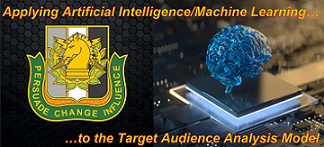[Editor’s Note: Our regular readers know the Mad Scientist Laboratory continues to explore the potential benefits Artificial Intelligence and Machine Learning (AI/ML) bring to the future of warfighting and the Operational Environment. As Dr. James Mancillas so eloquently stated, “The integration of future AI systems has the potential to permeate the entirety of military operations, from acquisition philosophies to human-AI team collaborations.” Warfighting is a process-rich endeavor, where speed is oftentimes the decisive factor. AI/ML can overcome limits in human cognitive abilities to provide our Warfighters with a battlefield “edge.”
Today’s post adds to our compendium of understanding with MSG Casey A. Kendall‘s submission exploring how AI/ML could complement (but not replace!) human instinct and intuition in Psychological Operations (PSYOPS) by applying its sheer information processing power and machine speed to analyze Target Audiences (TA) in our on-going endeavor to “Persuade, Change, Influence” our competitors and adversaries. MSG Kendall’s submission was the first runner up in our fourth annual Army Mad Scientist / U.S. Army Sergeants Major Academy (SGM-A) Writing Contest — Enjoy!]
The topic of artificial intelligence and machine learning (AI/ML) increasingly headlines conversations throughout a variety of professions. From law firms to academia, experts attempt to identify how the use of AI/ML can benefit their field; conversely, these experts are also examining the potential for AI/ML to circumvent or corrupt processes within their field. Regardless of the viewpoint, all understand that AI/ML is a powerful tool and in one way or another it is the way of the future. Within the Psychological Operations (PSYOP) regiment, planners are continuously evaluating their own processes to ensure they incorporate new innovations and technologies to outpace our adversaries; however, far too often the speed of innovation and the bureaucracy of applying new techniques keeps the field two steps behind. AI/ML is a technology that PSYOP cannot live without and if it cannot incorporate this tool, its adversaries will quickly outpace. PSYOP must adapt its processes to include the use of AI/ML platforms to augment human instinct and intuition as practitioners conduct target audience analysis to develop effective influence and persuasion products and actions.
without and if it cannot incorporate this tool, its adversaries will quickly outpace. PSYOP must adapt its processes to include the use of AI/ML platforms to augment human instinct and intuition as practitioners conduct target audience analysis to develop effective influence and persuasion products and actions.
A Brief Primer on the Target Audience Analysis Model
TAAM has been in existence in its current form since the late 1990’s, albeit with revisions made to account for changes in methods of communication and reach since that time. The purpose of U.S. Army PSYOP is to influence the attitudes, values, beliefs, and ultimately the behavior of selected groups or individuals in support of U.S. national interests and military objectives (Department of the Army [DA], 2022). Through an eight-step process, the PSYOP analyst uses the Target Audience Analysis Model (TAAM) to identify certain key elements which are necessary to effectively influence the target audience and change the desired behavior.
Through this process, the analyst selects and then refines target audiences (TA) based on their assessed ability to achieve the behavioral change. Analysts examine conditions to understand how the TA view the world around them and how that affects their current behavior. These conditions can be external, such as significant events or the TA’s immediate environment, or internal, such as attitudes, values, and beliefs (DA, 2022). An understanding of the conditions that affect the TA will lead the analyst to identify vulnerabilities which are those characteristics, motives, or conditions that the PSYOP practitioner hopes to exploit in order to influence the TA’s behavior (DA, 2013). 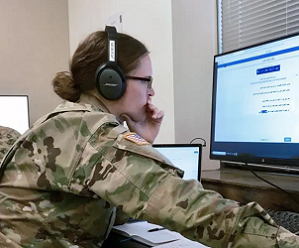 Once the analyst identifies the points of leverage by which they can most effectively influence the TA, they must then assess the level to which the TA is susceptible to influence. This step is crucial because it instructs the PSYOP practitioner about the balance between PSYOP messages and influence actions that planners must later develop. If the analyst assesses that the TA has low susceptibility, it means the TA is less susceptible to influence through traditional messaging. When this occurs, PSYOP planners will instead choose to influence the TA’s external environment by altering or manipulating existing conditions. Thus far, the analyst has focused on how the TA thinks or perceives the environment around them, but they must also consider how the TA receives and processes information from their environment.
Once the analyst identifies the points of leverage by which they can most effectively influence the TA, they must then assess the level to which the TA is susceptible to influence. This step is crucial because it instructs the PSYOP practitioner about the balance between PSYOP messages and influence actions that planners must later develop. If the analyst assesses that the TA has low susceptibility, it means the TA is less susceptible to influence through traditional messaging. When this occurs, PSYOP planners will instead choose to influence the TA’s external environment by altering or manipulating existing conditions. Thus far, the analyst has focused on how the TA thinks or perceives the environment around them, but they must also consider how the TA receives and processes information from their environment.
Once the analyst identifies the best approach for developing their influence products (either messages or actions), they must engage in an eight-step process to describe the TA’s accessibility, or their availability for influence targeting through a variety of media types or engagements (DA, 2022). Accessibility not only assesses traditional media such as television, radio, newspapers, or even the internet, but also key communicators, influencers, or non-traditional channels that may be unique or relevant to that particular TA. This step ties directly to the next step in which the analyst develops arguments and recommended psychological actions.
Based on the TA’s assessed level of susceptibility to influence messages, the analyst may develop arguments (previously referred to as lines of persuasion), which serve as a narrative theme and overall approach to guide influence messaging. If the TA’s level of susceptibility indicates that actions will provide better results, the analyst will recommend potential vulnerabilities related to the assessed conditions that can be exploited. Affecting these vulnerabilities leads to the desired behavioral changes by manipulating the conditions that result in the current behavior (DA, 2022). While these recommendations are  expected to meet the psychological objectives based on the prerequisite analysis, a thorough assessment of the effects of PSYOP efforts are necessary to show if they were successful or require modification. During the final step of the TAAM, the analyst refines the initial assessment criteria identified in step one and selects specific indicators they expect to observe following the execution of a series of messages, actions, or both (DA, 2022). Like an intelligence collection plan, this is a systematic collection of PSYOP-relevant information from all available sources. The indicators answer the questions posed within the assessment criteria, providing PSYOP practitioners with an understanding of the level to which their PSYOP efforts have been successful.
expected to meet the psychological objectives based on the prerequisite analysis, a thorough assessment of the effects of PSYOP efforts are necessary to show if they were successful or require modification. During the final step of the TAAM, the analyst refines the initial assessment criteria identified in step one and selects specific indicators they expect to observe following the execution of a series of messages, actions, or both (DA, 2022). Like an intelligence collection plan, this is a systematic collection of PSYOP-relevant information from all available sources. The indicators answer the questions posed within the assessment criteria, providing PSYOP practitioners with an understanding of the level to which their PSYOP efforts have been successful.
Assessing current effectiveness in order to improve future effectiveness is where incorporating AI/ML becomes most relevant. Over the years, new technologies have consistently affected the process of analyzing selected target audiences for the purpose of marketing and influence (Huang & Rust, 2021). PSYOP is similar to commercial marketing and derives much of its doctrine and techniques from modern marketing; experts in behavioral psychology such as Malcolm Gladwell and Dr. Robert Cialdini have influenced the field just as much as Sun-Tzu. This is because they share similar goals, and  the means to reach those goals are fairly universal. PSYOP creates a potential TA list and then narrows it down to a refined TA list. Similarly, commercial marketing does the same, though with different terminology calling these activities market segmentation and market research. PSYOP analyzes the conditions on a TA to identify potential points of leverage called vulnerabilities; marketing seeks to influence the consumer decision-making process in much the same way, catering to known vulnerabilities in the consumers’ conditions. In the end, both PSYOP and marketing reach their end states via similar processes. Sergio Zyman, Coca Cola marketing guru from the 1980’s, stated it like this: “The sole purpose of marketing is to get more people to buy more of your product, more often, for more money” (1999, p. 11). In essence, their shared processes and goals require greater levels of effectiveness at each step forward. If the principles and techniques shared by PSYOP and marketing are so similar, PSYOP must also strive to incorporate the tools marketing uses to increase its effectiveness.
the means to reach those goals are fairly universal. PSYOP creates a potential TA list and then narrows it down to a refined TA list. Similarly, commercial marketing does the same, though with different terminology calling these activities market segmentation and market research. PSYOP analyzes the conditions on a TA to identify potential points of leverage called vulnerabilities; marketing seeks to influence the consumer decision-making process in much the same way, catering to known vulnerabilities in the consumers’ conditions. In the end, both PSYOP and marketing reach their end states via similar processes. Sergio Zyman, Coca Cola marketing guru from the 1980’s, stated it like this: “The sole purpose of marketing is to get more people to buy more of your product, more often, for more money” (1999, p. 11). In essence, their shared processes and goals require greater levels of effectiveness at each step forward. If the principles and techniques shared by PSYOP and marketing are so similar, PSYOP must also strive to incorporate the tools marketing uses to increase its effectiveness.
Artificial Intelligence: A Tool to Improve Effectiveness
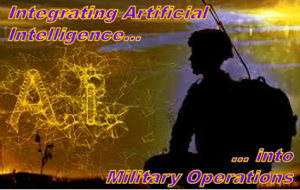 Analyzing target audiences is fairly laborious and often constrained by time, access to information, or the varying levels of experience individual PSYOP practitioners possess related to identifying crucial information in the focus areas in the TAAM. These factors, combined with the ambiguity about where to find relevant information creates a situation in which the finished product may miss the intended mark. The analyst must know which parts of the information are relevant, and what to make of the information once it is screened, reviewed, and assessed. Quality training and operational experience create analysts who are competent and capable of providing thorough target audience analysis, but their efforts to address complex and ill-structured problems could still benefit from computer-assisted analytical support in the form of AI/ML.
Analyzing target audiences is fairly laborious and often constrained by time, access to information, or the varying levels of experience individual PSYOP practitioners possess related to identifying crucial information in the focus areas in the TAAM. These factors, combined with the ambiguity about where to find relevant information creates a situation in which the finished product may miss the intended mark. The analyst must know which parts of the information are relevant, and what to make of the information once it is screened, reviewed, and assessed. Quality training and operational experience create analysts who are competent and capable of providing thorough target audience analysis, but their efforts to address complex and ill-structured problems could still benefit from computer-assisted analytical support in the form of AI/ML.
The Army Design Methodology describes complex problems that lack an immediately identifiable solution and present competing advantages and disadvantages as ill-structured (DA, 2015). These types of problems require planners to account for large amounts of information to gain an understanding of the problem and the environment in which it exists. The challenge with ill-structured problems and setting them apart from other problems is that planners do not possess the ability to solve them with an algorithm or a single technique, nor do they have a single best answer. In fact, they often have more than one solution, each with its own advantages and disadvantages (Meyer et al., 2014). Likewise, the PSYOP planner, regardless of skill, seeks to solve ill-structured problems that possess neither an easy answer nor a simple means to answer the solution manually. Companies in the private sector are finding themselves in very similar situations where there is simply too much information for even a team of people to reasonably manage (Liberatore & Luo, 2010).
 Many professional fields have begun to apply specific applications of AI/ML support to their own activities — enabling them to complete large amounts of research, technical writing, or modeling and simulation with greater effects. In the legal field, one company reports that they employ AI/ML platforms to recognize and extract specific kinds of clauses within contracts. The analyst can upload hundreds of contracts and provide the platform with specific types of legal provisions — termination clauses for example — and the system will respond with a spreadsheet containing every termination provision within the uploaded contracts (C. Bell, personal communication, January 22, 2023).
Many professional fields have begun to apply specific applications of AI/ML support to their own activities — enabling them to complete large amounts of research, technical writing, or modeling and simulation with greater effects. In the legal field, one company reports that they employ AI/ML platforms to recognize and extract specific kinds of clauses within contracts. The analyst can upload hundreds of contracts and provide the platform with specific types of legal provisions — termination clauses for example — and the system will respond with a spreadsheet containing every termination provision within the uploaded contracts (C. Bell, personal communication, January 22, 2023).  Additionally, the ML aspect allows the analyst to provide feedback when the AI/ML correctly or incorrectly identifies the desired information and learns for future improvement. The representative from this law firm estimates that by using AI/ML, the firm saves hundreds of hours in arduously screening every contract line by line. The AI/ML does not remove the human operator from the process, but instead augments and improves the human instinct and intuition that comes from practical experience (Gelder et al., 2021). For PSYOP, the TAAM process and its outputs are an opportunity-rich environment in which AI/ML can support data screening, research, and the overall analysis that goes into the process.
Additionally, the ML aspect allows the analyst to provide feedback when the AI/ML correctly or incorrectly identifies the desired information and learns for future improvement. The representative from this law firm estimates that by using AI/ML, the firm saves hundreds of hours in arduously screening every contract line by line. The AI/ML does not remove the human operator from the process, but instead augments and improves the human instinct and intuition that comes from practical experience (Gelder et al., 2021). For PSYOP, the TAAM process and its outputs are an opportunity-rich environment in which AI/ML can support data screening, research, and the overall analysis that goes into the process.
Data Screening
One of the most important steps in the military decision-making process is mission analysis, and yet it is often the part of the process that is most constrained by time. This creates a situation in which the planner attempts to glean the most amount of information possible from the vast body of knowledge, but risks missing key information that proves to be crucial to understanding the Operational Environment, the mission, or the enemy. 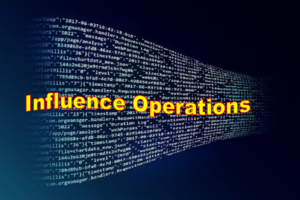 PSYOP suffers from this same problem when conducting TA analysis. The individual planner only has a finite resource of time to screen and assess the near limitless amount of data and determine which of it is relevant and useful to the analysis process (Liberatore & Luo, 2010). Even when a team of planners performs TA analysis as a collective group, they only marginally improve the process of screening all sources for relevant data. The team needs a tool that can scan the seemingly endless body of knowledge and identify not only the correct resources, but also the necessary information required to accurately and completely analyze the TA.
PSYOP suffers from this same problem when conducting TA analysis. The individual planner only has a finite resource of time to screen and assess the near limitless amount of data and determine which of it is relevant and useful to the analysis process (Liberatore & Luo, 2010). Even when a team of planners performs TA analysis as a collective group, they only marginally improve the process of screening all sources for relevant data. The team needs a tool that can scan the seemingly endless body of knowledge and identify not only the correct resources, but also the necessary information required to accurately and completely analyze the TA.
Research Improvement
Locating the information and screening it for completeness and relevance is only the first step. Once the AI/ML platform has identified the appropriate and relevant information to support the TA analysis, it can organize this information in a way that is consumable for the analyst. If the PSYOP analyst 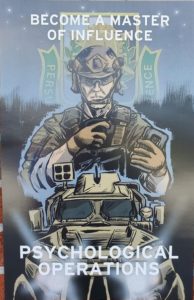 needs to specifically analyze the internal conditions on a refined TA in country X, the AI/ML can collate and organize the information according to the preferences of the analyst and the specifics of the analysis, allowing the analyst to apply the information more quickly and efficiently than they would be able to do without the AI/ML support (Liberatore & Luo, 2010). The use of AI/ML in support of the TAAM process does not divest the analyst from the process but augments and improves the product by the inclusion of the AI/ML platform outputs. The analyst is still an integral part of the analysis as is the research that feeds the analysis (Gelder et al., 2021). By first packaging the information, with emphasis on the most relevant and critical information, the analyst can focus on the information expected to have the greatest impact on the analysis and the end product.
needs to specifically analyze the internal conditions on a refined TA in country X, the AI/ML can collate and organize the information according to the preferences of the analyst and the specifics of the analysis, allowing the analyst to apply the information more quickly and efficiently than they would be able to do without the AI/ML support (Liberatore & Luo, 2010). The use of AI/ML in support of the TAAM process does not divest the analyst from the process but augments and improves the product by the inclusion of the AI/ML platform outputs. The analyst is still an integral part of the analysis as is the research that feeds the analysis (Gelder et al., 2021). By first packaging the information, with emphasis on the most relevant and critical information, the analyst can focus on the information expected to have the greatest impact on the analysis and the end product.
Overall Analysis
Once the AI/ML identifies and categorizes the information and the analyst has reviewed it, the real work takes place. As described previously, there are eight steps in the TAAM and each of these steps are necessary to fully understand and target certain groups or individuals to reach the desired behavioral change. One of the advantages to implementing AI/ML in support of the analysis process is its ability to take the information and internally wargame it.  Calculating the expected outcomes, the system can provide the analyst with an estimate of effectiveness when applied to hypothetical PSYOP products and actions (Alt et al., 2018). For example, if human analysts were to analyze TA “A”, the aforementioned time constraints may only allow the analyst or the analytical team enough time to wargame the expected results for two or three possibilities. AI/ML, on the other hand, could exercise multiple possibilities quickly and offer mathematical estimates of the expected level of effectiveness. The AI/ML platform, using inputs from the analyst to refine the wargame and account for any desired changes to the intended outcomes, provides timely and accurate analysis that the analyst can package and provide to the planners during the next phase of the PSYOP process, series development.
Calculating the expected outcomes, the system can provide the analyst with an estimate of effectiveness when applied to hypothetical PSYOP products and actions (Alt et al., 2018). For example, if human analysts were to analyze TA “A”, the aforementioned time constraints may only allow the analyst or the analytical team enough time to wargame the expected results for two or three possibilities. AI/ML, on the other hand, could exercise multiple possibilities quickly and offer mathematical estimates of the expected level of effectiveness. The AI/ML platform, using inputs from the analyst to refine the wargame and account for any desired changes to the intended outcomes, provides timely and accurate analysis that the analyst can package and provide to the planners during the next phase of the PSYOP process, series development.
This is not to suggest that the AI/ML platform would develop the actual PSYOP messages or craft the psychological actions within series development. The computations from the AI/ML support a greater depth of understanding regarding the conditions, vulnerabilities, and accessibility, as well as the most likely levels of susceptibility. These resources provide the analyst and planner a deeper understanding of the TA, compared to manual research and analysis alone. TA analysis is critical to the development of effective PSYOP messages and actions; therefore, it is paramount that the PSYOP practitioner fully understand the TA and why it behaves in a particular way (DA, 2007). While the AI/ML is the tool used to increase that depth and efficiency, it is still the PSYOP analyst who must apply due diligence and proper ethics when determining the final analysis of each TA.
Ethical Use of Artificial Intelligence in the TAAM Process
As with anything new and shiny, you can have too much of a good thing. Increasing research shows that ethical practice must govern the field of AI/ML and its use (Gelder et al., 2021). Though this is not a new topic, it is a subject that analysts must consider as AI/ML becomes more commonly used and accepted. It would be irresponsible for the PSYOP community to implement a practice that gives over the wholesale process of TA analysis to an AI/ML system without the referenced human interaction throughout the process and  as the final reviewer of quality assurance and control. Retaining the PSYOP analyst throughout the entire process ensures better-informed Soldiers who can inject instinct, intuition, and experience into the process. Where the AI/ML will speak in outputs of relative statistical probability, the human component can more accurately incorporate nuance and exceptions to the statistical probability (Gelder et al. 2021). The human component must remain an integral part of the process, though as a matter of integrity, they must also account for the participation of the machine. Through this ethical interaction, the PSYOP analyst can enable further development of PSYOP products and actions with the highest level of confidence that the data is accurate and relevant.
as the final reviewer of quality assurance and control. Retaining the PSYOP analyst throughout the entire process ensures better-informed Soldiers who can inject instinct, intuition, and experience into the process. Where the AI/ML will speak in outputs of relative statistical probability, the human component can more accurately incorporate nuance and exceptions to the statistical probability (Gelder et al. 2021). The human component must remain an integral part of the process, though as a matter of integrity, they must also account for the participation of the machine. Through this ethical interaction, the PSYOP analyst can enable further development of PSYOP products and actions with the highest level of confidence that the data is accurate and relevant.
Conclusion
PYSOP doctrine and processes must adapt to incorporate the understanding and use of AI/ML platforms to augment human instinct and intuition when conducting TA analysis. As PSYOP practitioners move forward into newer and more complex Operational Environments, the amount of relevant and applicable information continues to grow. The sheer volume of this information dictates that PSYOP analysts can no longer rely solely on manual techniques to review and screen the available information in a reasonable amount of time. The modern PSYOP professional cannot be successful without computer assistance when it comes  to identifying, assessing, analyzing, and applying the full body of knowledge available. The nature of warfare now and in the future is such that AI/ML in varying forms will become more and more necessary, not only in the PSYOP field, but in other areas of military decision making and planning.
to identifying, assessing, analyzing, and applying the full body of knowledge available. The nature of warfare now and in the future is such that AI/ML in varying forms will become more and more necessary, not only in the PSYOP field, but in other areas of military decision making and planning.
If you enjoyed this post, check out the SGM-A Class 73’s winning submission — Universal Soldier, by proclaimed Mad Scientist MSG Greg A. McGowan
… as well as the following related content:
Psychological Warfare in the Human Domain: Mixing AI-Powered Technology with Psychosocial Engagement and “I Know the Sound it Makes When It Lies” AI-Powered Tech to Improve Engagement in the Human Domain, by COL Arnel P. David, LTC (Ret) Patrick James Christian, PhD, and Dr. Aleksandra Nesic
Chatty Cathy, Open the Pod Bay Doors: An Interview with ChatGPT and associated podcast, with Chatty Cathy, an instance of ChatGPT by OpenAI
Hey, ChatGPT, Help Me Win this Contract! and associated podcast with LTC Robert Solano
Keeping the Razor’s Edge: 4th PSYOP Group’s Innovation and Evolution Council, by members of the 4th Psychological Operations Group (4th POG) Innovation and Evolution Council
Two Vignettes: How Might Combat Operations be Different under the Information Joint Function? by proclaimed Mad Scientist Dr. Christopher Paul
Artificial Intelligence: An Emerging Game-changer
Takeaways Learned about the Future of the AI Battlefield and associated information paper
The Guy Behind the Guy: AI as the Indispensable Marshal, by Brady Moore and Chris Sauceda
Integrating Artificial Intelligence into Military Operations, by Dr. James Mancillas
“Own the Night” and the associated Modern War Institute podcast with proclaimed Mad Scientist Mr. Bob Work
AI Enhancing EI in War, by MAJ Vincent Dueñas
The Human Targeting Solution: An AI Story by CW3 Jesse R. Crifasi
An Appropriate Level of Trust…
There Will Be Data and associated podcast, with Inderpal Bhandari
Disclaimer: The views expressed in this blog post do not necessarily reflect those of the U.S. Department of Defense, Department of the Army, Army Futures Command (AFC), or Training and Doctrine Command (TRADOC).
References
Alt, J., Morey, C., & Larimer, L. (2018). Perspectives on combat modeling. Phalanx, 51(4), 28-31. https://www.jstor.org/stable/10.2307/26553372
Department of the Army. (2007). Psychological operations process tactics, techniques, and procedures (FM 3-05.301). https://info.publicintelligence.net/USArmy-PsyOpsTactics.pdf
Department of the Army. (2013). Military information support operations (FM 3-53). https://armypubs.army.mil/ProductMaps/PubForm/Details.aspx?PUB_ID=102936
Department of the Army. (2015). Army design methodology (ATP 5-0.1). https://armypubs.army.mil/ProductMaps/PubForm/Details.aspx?PUB_ID=105348
Department of the Army. (2022). The psychological operations force influence process task: analyze (TM 3-53.11). https://armypubs.army.mil/ProductMaps/PubForm/Details.aspx?PUB_ID=1025079
Gelder, A, Lockwood, J., Roberts, C., Williams, A., & Conley, K. (2021). Ethical considerations for the use of machine learning in military personnel management (IDA Paper NS P- 22652). Institute for Defense Analyses. https://www.jstor.org/stable/resrep33498
Huang, M. & Rust, R. (2021). A strategic framework for artificial intelligence in marketing. Journal of the Academy of Marketing Science, 49, 30-50. https://doi.org/10.1007/s11747-020-00749-9
Liberatore, M. & Luo, W. (2010). The analytics movement: Implications for operations research. Interfaces, 40(4), 313-324. https://www.jstor.org/stable/40793168
Meyer, G., Adomavicius, G., Johnson, P., Elidrisi, M., Rush, W., Sperl-Hillen, J., & O’Connor, P. (2014). A machine learning approach to improving dynamic decision making. Information Systems Research, 25(2), 239-263. https://www.jstor.org/stable/24700172
Zyman, S. (1999). The end of marketing as we know it. Harper Business.

